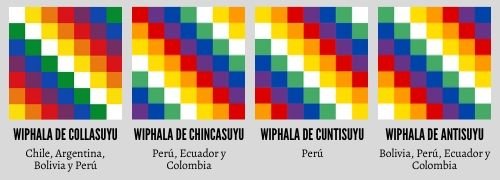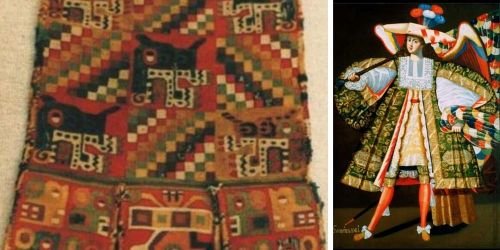What is the wiphala flag
Wiphala flag
What is the wiphala flag
The wiphala flag, wiphala emblem or wiphala is the symbol of the indigenous peoples of the Tahuantinsuyo, which covers the Andean area of Argentina, Chile, Bolivia, Peru, Ecuador and Colombia. The wiphala describes a quadrangular surface divided into 49 squares, colored diagonally with the colors of the rainbow.
There are four versions of the wiphala, hardly differentiated by the order of the colors. Each version represents one of the regions of the Tahuantinsuyo ('four territories' in the Quechua language). These territories are: Collasuyu, Chincasuyu, Antisuyu and Cuntisuyu. The best known wiphala is that of Collasuyu, where the Aymara or Aymara are found.
 Version of the wiphala according to each of the four territories of Tahuantinsuyo.
Version of the wiphala according to each of the four territories of Tahuantinsuyo.
Meaning of the wiphala flag
The meaning of the wiphala is very complex, since it represents the cosmogony of the Tahuantinsuyo peoples. It symbolizes two fundamental values of the Andean ethnic groups: the Pachakama , a principle of Universal order, and the Pachamama , which refers to Mother Earth, to the cosmos. Everything is linked in the values of solidarity, brotherhood and community.
Some researchers argue that in pre-Columbian times the wiphala was related to daily or economic activities (agriculture, textiles, etc.), and was linked to the Inca calendar.
The wiphala is also a symbol of traditions and customs, of shared joys and sorrows. Thus, it is raised in community celebrations, solemn parties, indigenous popular festivities, dances, etc.
Today, the wiphala has become a symbol of indigenous resistance to modern political-economic practices of domination. Likewise, it is a symbol of cultural diversity or, more specifically, of equality and unity in diversity.
The word wiphala comes from the Aymara or Aymara culture. It is formed by the union of two terms: wiphai , which refers to an exclamation of triumph, and laphaqi , whose approximate translation is 'object that flutters in the wind'.
It may interest you: Quechua .
Meaning of the colors of the wiphala
The colors of the wiphala are taken from the rainbow, which the Tahuantinsuyo cultures interpret as a reference to the ancestors. Each color has a specific meaning.
- Blue : cosmic space and its influence on the earthly world.
- Yellow : strength and energy, linked to moral principles and values of solidarity.
- White : time and transformation process that brings intellectual and work growth. Also symbol of the Markas (regions) and Suyus (regions).
- Orange : symbol of culture and society, as well as the preservation of the species.
- Red : represents the planet.
- Green : economy, linked to land and territory.
- Violeta : political and ideological order of the culture itself.
History of the wiphala flag
 Left: Aboriginal fabric from the Tiwaunakota period, Brooklyn Museum.
Left: Aboriginal fabric from the Tiwaunakota period, Brooklyn Museum.
Right: Attributed to the Master of Calamarca: Archangel Gabriel as an arquebusier , Church of Calamarca, Bolivia, s. XVIII.
The historical origin of the wiphala is uncertain. It is known that the essential elements of the wiphala design existed since pre-Columbian times, but not as a flag but as a kind of emblem, since the flags were introduced in America by Europeans.
There are references in aboriginal art and in colonial art that account for the existence of textiles and other implements where the basic form of the wiphala appears.
The Wiphala flag of the Aymara people began to spread widely in the contemporary world in the 1970s. This was due to the mobilizations and protests of the indigenous peasant unions that took place in Bolivia during that period.
In 1987 in Bolivia, a group of researchers undertook the task of investigating the symbols of the Tahuantinsuyo cultures and the records that reveal the presence and evolution of the wiphala. From this research, current versions of the wiphala were built.
The Aymara or Collasuyu wiphara was constitutionally recognized as a symbol of the State of Bolivia since 2008, during the administration of Evo Morales.
Update date: February 28, 2021.
Recommended content
60 qualities and defects of a personAbstraction: What is it, Characteristics, Types
Floods » What is it, Characteristics, Concepts
Histology: What is it, History, Methods, Branches
Narrative text: What is it, Characteristics, Types
Roman Law › What is it, Characteristics, Sources, Periods
Sources of law › What is it, Characteristics, Examples
10 Characteristics of Autism
10 Characteristics of Autocracy
10 Characteristics of Birds